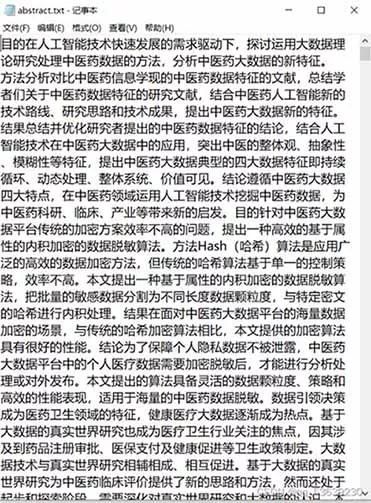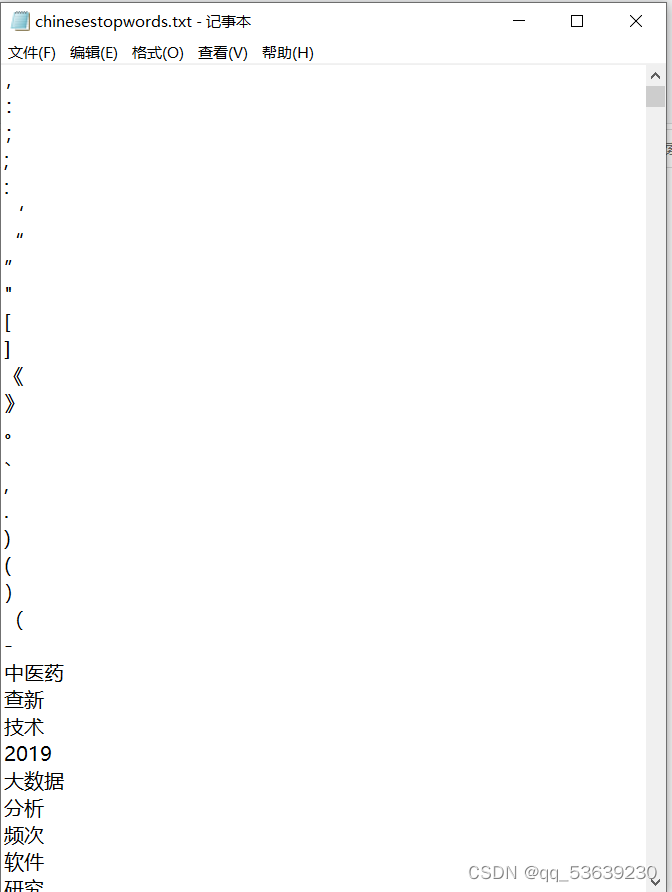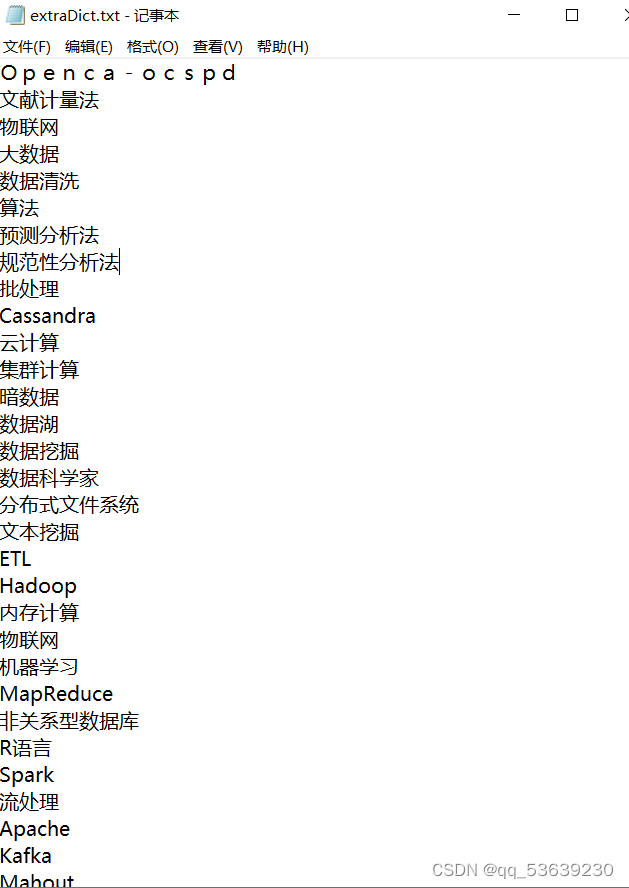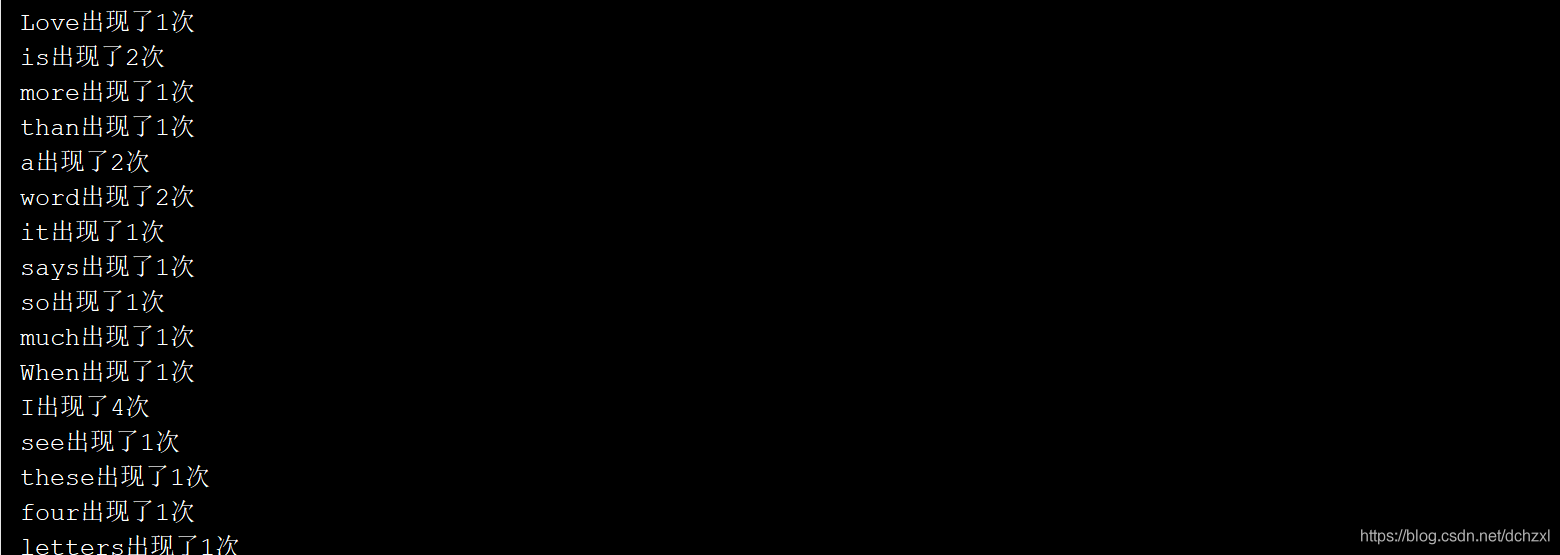python中文分词+词频统计的实现步骤
前言
一、文本导入
二、使用步骤
1.引入库
2.读入数据
3.取出停用词表
4.分词并去停用词(此时可以直接利用python原有的函数进行词频统计)
5. 输出分词并去停用词的有用的词到txt
6.函数调用
7.结果
附:输入一段话,统计每个字母出现的次数
总结
提示:文章写完后,目录可以自动生成,如何生成可参考右边的帮助文档
前言本文记录了一下Python在文本处理时的一些过程+代码
一、文本导入我准备了一个名为abstract.txt的文本文件

接着是在网上下载了stopword.txt(用于结巴分词时的停用词)

有一些是自己觉得没有用加上去的
另外建立了自己的词典extraDict.txt

准备工作做好了,就来看看怎么使用吧!
二、使用步骤 1.引入库代码如下:
import jieba
from jieba.analyse import extract_tags
from sklearn.feature_extraction.text import TfidfVectorizer
2.读入数据
代码如下:
jieba.load_userdict('extraDict.txt') # 导入自己建立词典
3.取出停用词表
def stopwordlist():
stopwords = [line.strip() for line in open('chinesestopwords.txt', encoding='UTF-8').readlines()]
# ---停用词补充,视具体情况而定---
i = 0
for i in range(19):
stopwords.append(str(10 + i))
# ----------------------
return stopwords
4.分词并去停用词(此时可以直接利用python原有的函数进行词频统计)
def seg_word(line):
# seg=jieba.cut_for_search(line.strip())
seg = jieba.cut(line.strip())
temp = ""
counts = {}
wordstop = stopwordlist()
for word in seg:
if word not in wordstop:
if word != ' ':
temp += word
temp += '\n'
counts[word] = counts.get(word, 0) + 1#统计每个词出现的次数
return temp #显示分词结果
#return str(sorted(counts.items(), key=lambda x: x[1], reverse=True)[:20]) # 统计出现前二十最多的词及次数
5. 输出分词并去停用词的有用的词到txt
def output(inputfilename, outputfilename):
inputfile = open(inputfilename, encoding='UTF-8', mode='r')
outputfile = open(outputfilename, encoding='UTF-8', mode='w')
for line in inputfile.readlines():
line_seg = seg_word(line)
outputfile.write(line_seg)
inputfile.close()
outputfile.close()
return outputfile
6.函数调用
if __name__ == '__main__':
print("__name__", __name__)
inputfilename = 'abstract.txt'
outputfilename = 'a1.txt'
output(inputfilename, outputfilename)
7.结果

先来讲一下思路:
例如给出下面这样一句话
Love is more than a word
it says so much.
When I see these four letters,
I almost feel your touch.
This is only happened since
I fell in love with you.
Why this word does this,
I haven’t got a clue.
那么想要统计里面每一个单词出现的次数,思路很简单,遍历一遍这个字符串,再定义一个空字典count_dict,看每一个单词在这个用于统计的空字典count_dict中的key中存在否,不存在则将这个单词当做count_dict的键加入字典内,然后值就为1,若这个单词在count_dict里面已经存在,那就将它对应的键的值+1就行
下面来看代码:
#定义字符串
sentences = """ # 字符串很长时用三个引号
Love is more than a word
it says so much.
When I see these four letters,
I almost feel your touch.
This is only happened since
I fell in love with you.
Why this word does this,
I haven't got a clue.
"""
#具体实现
# 将句子里面的逗号去掉,去掉多种符号时请用循环,这里我就这样吧
sentences=sentences.replace(',','')
sentences=sentences.replace('.','') # 将句子里面的.去掉
sentences = sentences.split() # 将句子分开为单个的单词,分开后产生的是一个列表sentences
# print(sentences)
count_dict = {}
for sentence in sentences:
if sentence not in count_dict: # 判断是否不在统计的字典中
count_dict[sentence] = 1
else: # 判断是否不在统计的字典中
count_dict[sentence] += 1
for key,value in count_dict.items():
print(f"{key}出现了{value}次")
输出结果是这样:

以上就是今天要讲的内容,本文仅仅简单介绍了python的中文分词及词频统计!
到此这篇关于python中文分词+词频统计的实现步骤的文章就介绍到这了,更多相关python中文分词 词频统计内容请搜索软件开发网以前的文章或继续浏览下面的相关文章希望大家以后多多支持软件开发网!